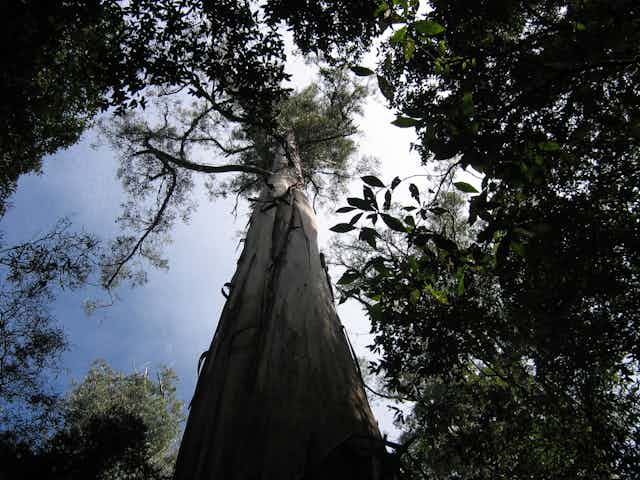Forest activist Miranda Gibson’s 15-month stay up a giant eucalypt has been interrupted by bushfire. Meanwhile Tasmania’s forestry peace deal, now being considered in the state’s upper house, has drawn attention to its policy on jobs and protected areas. However a vital ingredient is missing.
Fire is the unpredictable variable in Tasmania’s forests. Giant eucalypt forests depend on fire for survival, but are threatened by poor fire management and the increasing severity of fires in south-east Australia. Managing these forests is a balancing act, and fire demonstrates some of the complexities of forest conservation in Tasmania.
Gum trees, in a rainforest
Tasmania’s giant eucalypts can legitimately be considered as rainforests, because they occur precisely where rainforests are expected to occur - the wettest and most productive environments.
The catch is that to perpetuate themselves, giant eucalypts have a unique dependence on fire. Eucalypts in general have an ancient covenant with fire that stretches back over 60 million years. But the coupling of giant rainforest eucalypts with fire has serious consequences for conserving old-growth forests in Tasmania.
Ecologically speaking, gigantic eucalypts are pioneer plants - think gigantic weeds - that thrive in open conditions following intense fire. Resulting ash beds provide an abundance of nutrients and light, and the burnt ground is disease and competitor free. Over time the regenerating forest thickens and matures. Tiny eucalypt seeds - the size of a pinhead - can’t germinate due to competition with established plants.
Gigantic eucalypts are therefore transient components of the ecosystem. In Tasmania the giant eucalypts will eventually be succeeded by southern beech (Nothofagus) forests. The penultimate stage of this transition is a globally unique “double-decker” forest of giant eucalypts that towers above the temperate rainforest understorey.
Matters of succession
Forest conservation demands succession planning in the same way a family business does. These giant trees can live for over 500 years, which means a really long-range view is needed. Middle-aged forests must be represented in reserve systems, ensuring that current old-growth forest can be replaced when it dies of old age.
All the evidence is pointing to increased fire activity in Tasmania. Over the last two decades large swaths of the southwest Tasmanian World Heritage area burned in fires started by dry lightning that set fires in unusually dry vegetation.
Should lightning start fires in the southeastern Tasmania under drought conditions, forest will be burnt in conflagrations of epic proportions in terms of geographic extent and fire intensity. Such “megafires” have already occurred in Victoria over the last decade and may be changing Victoria’s ash forests.
Reserves of giant eucalypts are vulnerable to severe bushfires, which would kill off the old giants and begin the cycle again with a cohort or regenerating seedlings.
Bushfires are therefore extremely difficult to factor into conservation planning, especially now that Tasmania’s old-growth forests are fragmented by logging and hydroelectric dams.
Funding for fire management
The conservation focus of the current Tasmanian forest peace deal has been fixated on setting aside areas of old-growth forest from logging. Yet reserving old-growth forest is just part of the story. Protecting these remaining stands of giant trees will require a fire management capacity on standby, every summer.
Until now the forest industry has provided this, including maintenance of roads that help nip fire in the bud and staff with a skill set that can manage forest fires before they become extremely dangerous. It is debatable if the restructured Tasmanian forestry industry can still provide that capacity. Federal funding is on the table for the restructure but whether this includes bushfire management is unclear.
The national trend of running down conservation budgets is most apparent in Tasmania. There is a big question mark hanging over the peace deal as to where funding will come from.
Managing carbon in Tasmanian forests could generate the financial base and the motive to manage bushfires, as fire management is being used to manage emissions and fund conservation in northern savannas.
Carbon farming in Tasmanian forests is an attractive idea given the high density of carbon in giant eucalypt forests, but the business case needs to be better articulated and promoted.
The survival of old growth forest will hinge on sustained bushfire management. How this problem will be resolved remains unclear. One certainty is that protesting will be far less effective in stopping bushfires than protesting against logging.

